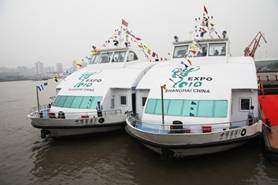Hi!
Welcome to Confucius Classroom Glow Blog, the first of a series of blog postings that will try to give students a broader understanding and clearer view of Shanghai, and China in general.
There’s been a lot of buzz lately concerning the Shanghai Expo in the past few months, and yet most people abroad only have a vague idea of what it is and what it’s supposed to be about.
To put it simply, think of it as a fair – you pay for a ticket to get in, and then you’re free to roam around the grounds and see the attractions. Indeed, previous Expos were known as “World’s Fairs,” except these “fairs” are on a massive scale, with hundreds of countries, regions and groups coming together to build their own structures or “pavilions” at the fair grounds.
The organiser’s authorisation of each pavilion is apolitical and indeed, certain pavilions like the Pacific Pavilion are comprised several countries together, and other pavilions like the Life & Sunshine Pavilion have no geographical connotations whatsoever.
The pavilions are each group’s creative interpretations of the Expo theme and allow them to showcase their culture within the set framework. This year’s Expo theme is “Better City – Better Life” and is the largest and most expensive Expo to date.
The sheer magnitude of the Expo sometimes escapes attention, and it can be a bit hard to get a feeling of the numbers involved. This year’s Expo will run for six months and will conclude at the end of October. During this time, it’s forecast that about 70 million people (over 13 times the population of Scotland) will visit the site. In fact, the more popular pavilions require visitors to queue in line for several hours! Can you imagine standing for several hours? Luckily, volunteer staff are on hand to help save your place in line if you need to use the washroom.
Several hundred thousand people pass through the Expo site each day, which covers a total area of 2.04 square miles (about 1/50th the size of Edinburgh). Here’s an aerial photo courtesy of Xinhua that shows a portion of the fair grounds:

The Expo actually takes place on both sides of the Huangpu River, so here’s another photo taken from a different angle:

Pavilions are grouped together regionally into “Zones,” and Scotland’s contribution to this year’s Expo is represented at the UK Pavilion, in Zone C:

What’s this weird looking fuzzy cube, you ask? It’s the centrepiece of the UK Pavilion, known as the “Seed Cathedral.” That “fuzz” effect you see on the outer edge of the cube isn’t an optical illusion – the Seed Cathedral is actually made of some 60,000 transparent acrylic rods that are almost 25 feet in length. At the end of each rod are embedded seeds from different plants, to represent the importance of nature in the future.

Here’s First Minister of Scotland Alex Salmond taking a closer look at these rods when he visited the site in July. You can see the seeds that have been painstakingly encased in each of the acrylic rods.
Edinburgh is also expressly featured within the UK Pavilion, complete with “green” maps to underscore the theme of “Better City – Better Life.”
It’s true that most visitors to the Expo are from the Chinese Mainland. And as such, the Expo not only showcases Shanghai to the world, but also offers a real opportunity to exchange cultures with Chinese on a one-to-one basis. It’s not just about walking around different buildings for the whole day, all pavilions have repeating shows or parades that occur throughout the six-month Expo period, with volunteers ready to explain their pavilions and guide visitors.
After going to the Expo several times already, my personal feeling is that there is a genuine interest in all these cultures by the vast majority of Chinese. A question was posted earlier asking about the types of Scottish products that were exhibited at the Expo and which ones were shown the most interest. I’m not sure there are any products per se, since the Expo is not really like a trade fair. But my feeling is that for those Chinese that show an interest in the UK Pavilion, Scotland’s natural scenery and landscape remain as one of the more captivating things in their hearts.
One of the more popular questions that others have asked is: “What happens to the pavilions after the conclusion of the Expo?” Most of them will be dismantled after each Expo, but a few select exceptions are kept and still exist today as modern icons. You might even know of them without realising their Expo origin – the Eiffel Tower is an example of one of these monuments!
For more information about the various sites, check out this 3D map of the Expo. The virtual tours for each pavilion are pretty cool, although the voice acting is quite annoying. You’ll see what I mean when you click on the pavilions. 🙂
So that’s it for the first blog post of the Confucius Classroom Glow Blog, what do you guys think? Feel free to leave any comments or questions, and I’ll do my best to respond as quickly as possible. This blog is for you, so do let us know what sort of topics you’re interested in learning about and we can take it from there.
Thanks!










